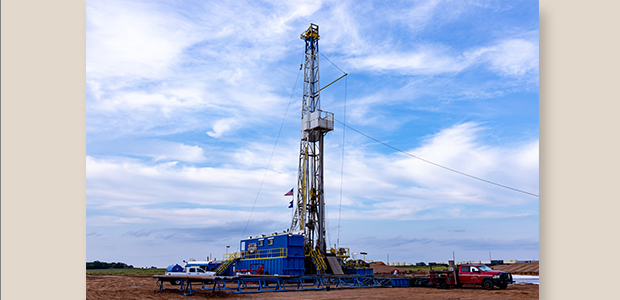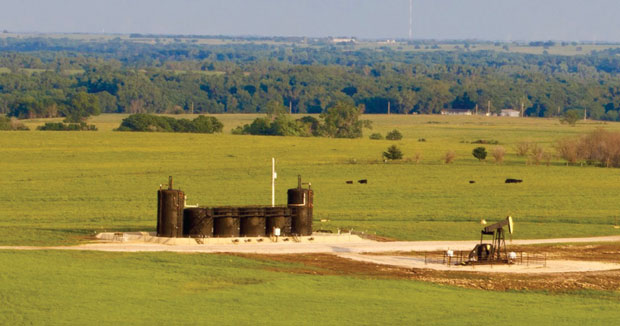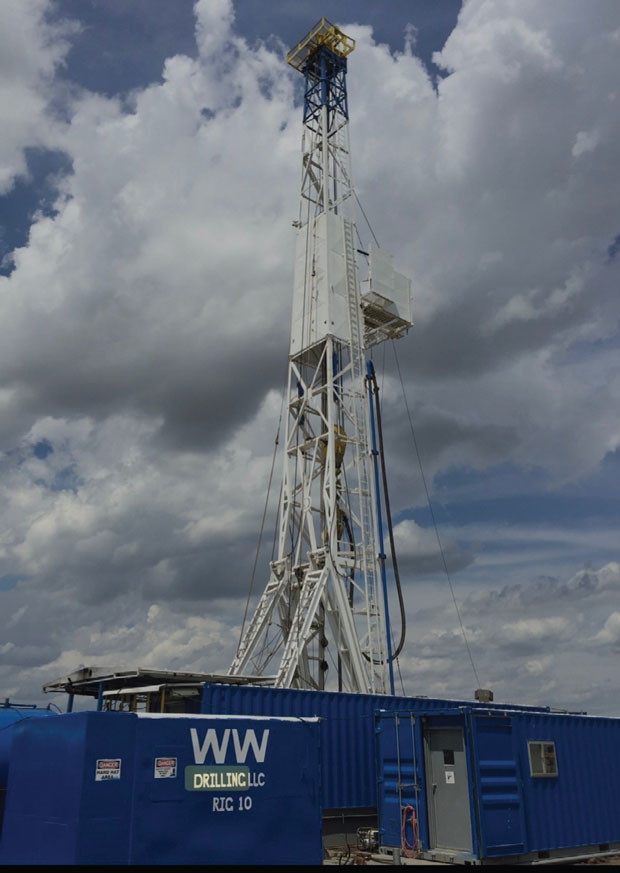
Conventional Vertical Drilling Keeps Independents Busy In Anadarko, Mid-Con Plays
By Danny Boyd
The rise of U.S. unconventional resource plays is a remarkable story, but the plot line can be summarized simply enough: find a new class of hydrocarbon reservoirs and lead the world in crude oil, condensate and natural gas production. However, one element of the narrative often is overlooked: A sizeable percentage of America’s stable baseline production comes from a huge number of lower-rate vertical wells.
While horizontal activity in unconventional basins continues to grab the headlines, public and private companies are conducting quiet vertical drilling campaigns off the beaten path, targeting conventional geology in regions including the Mid-Continent. In these vertical fields, production rates cannot begin to compare with horizontal resource plays, but then, neither do their drilling and completion costs, making the economics favorable for operators such as Trans Pacific Oil Corp., Mull Companies and Palomino Petroleum.
These companies focus on untapped horizons, deeper intervals and enhancing acquired proved, developed, producing assets through workovers and recompletions, and by applying a mix of 3-D seismic techniques, time-tested drilling technologies and innovative completion designs to maximize the productivity of conventional formations.
To set the backstory, the meteoric growth in U.S. oil and gas production during the past two decades may have come from long-lateral horizontals, but statistics from the U.S. Energy Information Administration show that 90% of all 913,000 active U.S. wells in 2022 made fewer than 100 barrels of oil equivalent a day, and nearly 80% yielded less than 15 boe/d. Even among horizontals, the majority of active wells produced fewer than 100 boe/d.
Clearly, lower-rate wells are a primary part of the U.S. supply pyramid. Horizontal wells with daily rates reaching 3,000 boe or more are at the top of that pyramid. Occupying a broad middle space are a larger population of older horizontals and newer verticals. The bottom tier is made up of an even larger number of wells: marginal properties that often are located in legacy fields operated by small private independents. These wells represent a small but consistent share of total U.S. production, accounting for 10% of total U.S. oil and 8% of natural gas production volumes, according to the National Stripper Well Association.
Mississippi Vertical Play
Operating more than 600 wells, Trans Pacific Oil Corp. is looking to build on a conventional position in northern Oklahoma, principally targeting the bread-and-butter Mississippi in Alfalfa and Woods counties, says company President Alan Banta.
Founded in 1980 with backing from Japanese investors, the Kansas-headquartered company entered Oklahoma in 2014 and was commencing the drilling of its newest well in Woods County in late July. New and reworked wells after seven acquisition deals in the Sooner State now number about 60, producing a combined 550 boe/d.
Trans Pacific Oil Corp. is drilling vertically in the Mississippi play in northern Oklahoma and southern Kansas. Given the lower drilling and completion costs, Trans Pacific’s economic returns on vertical Mississippi production rival the results from horizontal wells.
“We are interested in buying more leases and getting more involved with operators in Oklahoma,” says Banta, who owns Trans Pacific and handles investments through a limited partnership. “It is always a matter of finding the right fit.”
With a staff of 14 that includes two engineers and two geologists along with land, accounting and administrative staff, the company primarily has purchased PDP assets with development options. The staff relies on available 3-D seismic datasets and applies standard geological and engineering analysis to identify immediate upgrades through re-pressurizing zones, deploying polymer or tapping into oily uphole layers still behind pipe, Banta says.
In Oklahoma, average new well costs from drilling, completions and putting wells on pump average less than $750,000, he reports. In addition to the Mississippian, other prospective Oklahoma formations include the Viola, Wilcox and Simpson. The Misener also can be a target, although it is very inconsistent from one location to even an adjacent offsetting one, Banta points out.
“A horizontal well in the area can certainly capture more Mississippi, but when considering the cost to drill and return on investment, our vertical Mississippi results rival the best horizontal results,” Banta insists.
With limited water output from the Mississippian, a shallower disposal that can take in 1,500 barrels a day can accommodate as many as three producers, he says. The Mississippian formation is about 5,000 feet deep in Oklahoma. Completions in the highly variant lithology require fracture treatments that can include 10,000 barrels of fluid and 120,000 pounds of sand, he says. The company also uses diverter in some completions.
The formations in northern Oklahoma extend northward and trend upward across the state line into Kansas, where Trans Pacific is identifying prospects as part of a shift to southern Kansas from the Central Kansas Uplift.
After the newest Woods County, Ok., well, the company is expressing plans to drill a well on the uplift in Logan County, Ks., and the company also holds assets in Kansas’ Rooks and Ellis counties. According to Banta, completion costs are typically lower in Kansas because of fewer fracs and typical strategies that include limited-entry perforating with a small acid treatment and re-perf, followed by a larger acid job.
Armed with a trove of data from legacy wells and horizontal efforts a decade ago from majors and large independents, the company is identifying options in Barber, Ford, Harper and southern Kiowa counties in Kansas near the Oklahoma border, Banta concludes.
Bright Future
Across a position that includes assets in eastern Colorado and Kansas, Mull Companies is targeting the deeper horizons in the Hugoton embayment, the Morrow, Mississippian and Pennsylvanian, says Chief Executive Officer Jennifer Mull.
In Colorado, the company has secured an oil and gas development plan from the Colorado Energy & Carbon Management Commission as it looks to grow a position that includes the Northwest Arapahoe Unit near Cheyenne Wells. With the plan, the company is in the process of filing for a drilling permit as part of a larger process that can take between one and three years, she says.
In March, Mull Companies completed an acquisition of the deep rights beneath 71,000 acres on the Hugoton Embayment in western Kansas, where the company is analyzing 3-D seismic to target potential well locations targeting oil-rich horizons. The company says it expects a drilling program next year.
Founded in 1954 as Mull Drilling Co. by her grandfather, J.A. Mull Jr., the company operates 325 wells and has drilled nine in the past 12 months, but has slowed its pace as it puts the finishing touches on a strategy to guide future growth and focus on larger projects instead of smaller, individual prospects.
“We have been around for a long time and are planning for a bright future,” she describes. “We are very excited about our larger projects going forward.”
Mull Companies completed an acquisition in March of the deep rights beneath 71,000 acres on the Hugoton Embayment in western Kansas, where the company plans to focus its efforts for the foreseeable future.
In mid-summer, the company’s staff was analyzing 30 square miles of 3-D seismic to target potential well locations for targeting oil-rich horizons on the acquired deep rights, with drilling expected to begin next year, Mull reports.
The company also has seen success in a conventional drilling program targeting Ordovician rocks at a depth of about 3,000 feet in Lyon County north of Emporia, Ks.
Armed with knowledge from its coring work, Mull Companies has netted 10 producers on the position so far, including four new wells completed this year.
Out-Of-The-Box Approach
In Northwest and North Central Kansas, Palomino Petroleum continues to execute a vertical drilling program as it identifies prospects on 40,000 acres held by production and about 100,000 undeveloped acres, says company President Klee Watchous.
Overall, most drilling is self-funded with additional financing from a tight-knit group of working interest investors, he explains.
In Northwest and North-Central Kansas, Palomino Petroleum is executing an ongoing 3-D seismic-guided vertical oil drilling program targeting the Mississippian, Lansing, Kansas City, Marmaton and Cherokee Sand formations.
“We are looking at alternatives to get more of our drilling program accomplished,” he divulges. “We have a lot of ideas as we continue to drill and develop our acreage. We have not brought in outside investors or capital, but we are always interested in innovative ways to develop and drill. We may look at some out-of-the-box approaches, but we usually take a large amount of each deal ourselves, with the balance assumed by interest owners that have been with us for a long time.”
Daily oil production is around 1,500 bbl/d as part of an oil focus initiated by Watchous’ grandfather, R.W. Watchous, who founded the company in 1969 during an oil and gas career that began in the 1940s. The elder Watchous passed in 1993 and his grandson assumed management at age 19.
The company has tapped into oil finds in the Mississippian, Lansing, Kansas City, Marmaton, and Cherokee sands. A recent well drilled and completed in Northwest Kansas tapped into an unexpected zone yielding good production. The company is assessing the zone and developing a broader development plan to exploit it, Watchous reports.
To identify primarily crude oil prospects that often require little acid stimulation or fracturing, the Newton, Ks.-based company depends on extensive 3-D seismic and strong internal geological evaluation.
“It is unusual for us to frac,” Watchous explains. “We may fracture a well every once in a great while, but the vast majority of what we do are either natural completions or acid stimulations, which make for a much less expensive and less involved completion process.”
Diverter Applications
Other Mid-Continent conventional operators are experiencing better completion results in the Mississippian utilizing thermoplastic diverters during fracturing to control fracture height and allow fractures to extend farther laterally into oil-bearing benches, says Nick Koster, president of DiverterPlus Inc. in Denver.
Also deployed in the region’s unconventional wells, the solution is a 20-40 mesh powder mixed with frac fluid when pressure drops indicate excessive fracture height growth, he says.
“You must have a rather large frac to create enough conductivity to sustain production in some of those Mississippian wells, but the downside is that you can create a large fracture during stimulation. The longer that fracture is, the more it can include a lot of fracture height,” Koster explains. “The penalty of that height can be increased water production from lower formations if you get too low in the targeted zone.”
The diverter, which is not oil-activated, acts as a binder for proppant embedded in it. Essentially, the combination creates a controlled tip screen-out at the top and bottom of the fracture. The diverter converts to a liquid after fracturing without requiring additional intervention. Far-field applications require in-depth understanding of fracture mechanics and frac design, Koster adds.
Utilizing diverter technology, VAL Energy has drilled and completed some 60 wells in Mississippian oil wells in Cowley County in southern Kansas along the Oklahoma state line, says company president Todd Allam, who previously owned a frac company with Koster.
Expertise on frac assessments in the region was honed on 134 wells in Barber County, Ks., and applied in Cowley County with the diverter, says Allam, whose company drills an average of 12 wells a year.
While stimulating at 1,500 psi, sudden drops to 800 or 900 psi can indicate pumping into a fracture, he says. Applying the diverter can make a difference in only minutes and pressures typically recover quickly, which seems to indicate that new rock is being fractured farther out in the targeted zone.
“We have seen pressure spikes go to 2,000 or 3,000 pounds when that diverter hits that fracture network and plugs it off,” Allam remarks. “We have done extensive research and run microseismic surveys on wells stimulated both with and without diverter. We are having better results than we had originally just pumping sand and slickwater.”
RA Energy based in Lawrence, Ks., has realized success with the completion design on a variety of Mississippian horizons in Cowley County, where the company has 21 producing wells, says President Tom Rainey.
“I sat on the control room on several of the fracs and you could see the pressures change. That was clearly the diverter working so the frac could enter all these separate distinct horizons that we had open,” he recalls. “From there, we would let it set for 30 days and then hang it on the pump.”
Initial productivities on diverter-treated wells in Cowley County have ranged from 20 to 120 barrels per well, Rainey says. Altogether, the company has about 40 wells on more than 4,000 acres in Kansas’ Cowley, Ellis, and Sumner counties.
Completion Choices
Mid-Continent vertical completion designs vary widely because geological characteristics and target depths on the same formations also can vary, says Reed Hall, chief operating officer at Stimulation Pumping Services, which has Oklahoma yards in Blackwell and Cushing.
Serving Mid-Continent and Anadarko conventional and unconventional operators, the company indicates it has pumped acid, sand with slickwater, cross-linked borate gels or polymers, and carbon dioxide or nitrogen.
“I have seen operators run a chemical additive and make a heck of a difference, such as including an iron control additive in certain areas. But it is difficult to pinpoint one major completion development that can make or break a well in this region,” Hall says. “It is more a case of applying the right solution in the right application.”
Experimental designs in one well have been followed by different designs in similar rock within a couple of miles, with similar production results using similar sand volumes but adjustments in fluid.
“You might have a thin section of the Cleveland that may be 10 feet thick and you are only pumping 20,000 pounds of sand and 300 barrels of fluid, and that is the entire frac at 15 barrels a minute,” Reed says. “In other areas, there may be a 50-foot net section being stimulated with 100,000 pounds of sand and 2,200 barrels of fluid.”
Slickwater and sand has been effective in a variety of benches, he reports. Acids, and acid with scouring sand, have worked well in some portions of the horizonal Woodford, Mississippi, Mississippi Lime and Oswego. In the Merrimac play, high concentrations of slickwater and sand work well, as have high-viscosity polymers versus the use of a borate cross-linked system, Reed concludes.
For other great articles about exploration, drilling, completions and production, subscribe to The American Oil & Gas Reporter and bookmark www.aogr.com.


















